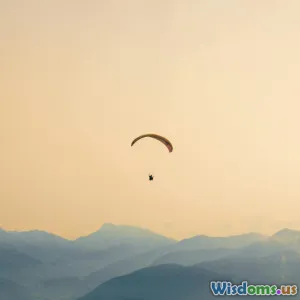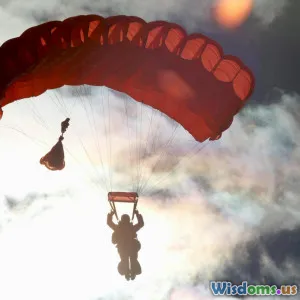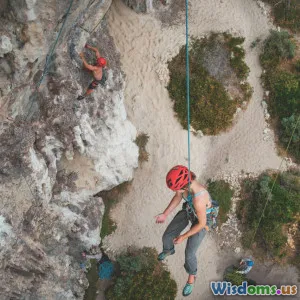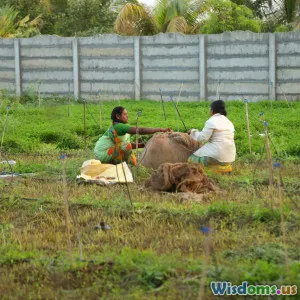
Paragliding in the Alps A Thrilling Guide for Beginners
9 min read Explore paragliding in the Alps with this beginner's guide featuring expert tips, top sites, and safety insights for an unforgettable aerial adventure. (0 Reviews)
Paragliding in the Alps: A Thrilling Guide for Beginners
Introduction
Imagine soaring silently above snow-capped peaks, the fresh mountain air filling your lungs, and breathtaking panoramas unfolding beneath you as you glide effortlessly across the sky. This is the magic of paragliding in the Alps, a dream destination for both seasoned pilots and adrenaline-seeking beginners alike. With some of the world’s most spectacular landscapes and ideal soaring conditions, the Alps offer an extraordinary venue for your first flight or your next aerial adventure.
This article is a comprehensive guide for beginners interested in paragliding in the Alps, providing everything from understanding essential equipment and safety to selecting the best launch sites and local insights. Whether you’re just curious or seriously considering taking the leap, read on to discover how you can safely and confidently embark on this unforgettable mountain journey.
What Makes the Alps Ideal for Paragliding?
Spanning eight countries and beckoning adventurers globally, the Alps present unique geographical and meteorological advantages for paragliding:
1. Varied Terrain and Scenic Vistas: From rolling green meadows to rugged limestone cliffs and glaciated summits, the diverse terrain creates perfect thermal activity helping pilots gain altitude. Take, for example, the Mont Blanc massif in France and Italy, offering jaw-dropping views and expansive landing zones.
2. Reliable Weather: Alpine valleys generate consistent updrafts during warm seasons, especially late spring through early autumn. Understanding and anticipating these conditions maximizes safe flying times.
3. World-Class Facilities: With established paragliding schools and rental services—such as those in Chamonix (France), Interlaken (Switzerland), and Como (Italy)—beginners can access expert instruction and equipment.
4. Vibrant Flight Communities: Competitions, festivals like the "Alpargliding Meeting" in Austria, and friendly local pilots add a welcoming culture to transform your learning curve into an enjoyable experience.
Essential Equipment for Beginners
Before the first flight, understanding the equipment used in paragliding is critical for safety and comfort.
-
Wing (Canopy): The heart of the setup, paragliders come in various sizes and designs. Beginners should use wings with high stability and gentle handling (classified as EN-A or EN-B), like Nova Mentor or Ozone Buzz models.
-
Harness: Provides seating and safety during flight. Beginners benefit from comfortable, ergonomic models with back protection.
-
Helmet: A lightweight, certified paragliding helmet (EN 966 standard) is mandatory.
-
Reserve Parachute: An essential safety feature installed in the harness for emergencies.
-
Variometer: An instrument measuring vertical speed to aid thermalling.
-
Clothing: Weather-resistant layers, gloves, and sturdy boots suitable for mountain conditions.
For those new to the sport, it is highly recommended to rent equipment from experienced providers or join a paragliding school where gear is carefully maintained and perfectly matched to skill level.
Finding the Best Beginner Launch Sites in the Alps
The Alps offer numerous beginner-friendly sites characterized by gentle wind conditions, easy take-offs, and forgiving landing areas:
1. Annecy, France
Famous for its turquoise lake backdrop and mild thermals, Annecy is a hotspot for learning paragliding. Schools like "L’Ecole de Vol Libre" offer tandem flights and introductory courses.
2. Interlaken, Switzerland
Nestled between Lake Thun and Lake Brienz beneath the majestic peaks Eiger, Mönch, and Jungfrau, Interlaken provides stunning scenery and generous flight windows. The local guides emphasize safe flying practices critical for newcomers.
3. Oludeniz, Austrian Alps
This site provides a safe environment with consistent winds, frequently used for beginners’ training and often utilized during international paragliding competitions.
4. Grindelwald, Switzerland
Another Swiss jewel, it features excellent infrastructure and several gentle slopes perfect for grasping the fundamentals.
Safety Check: Always check local weather reports, wind conditions, and communicate with certified instructors before flying.
Beginner Training: What to Expect
Paragliding instruction typically spans from ground handling lessons to tandem flights and solo cross-country practice.
Ground Handling
Learners start with understanding wing inflation, control, and emergency procedures on flat or slightly inclined terrain, often near the launch site. Mastery of kiting the wing builds muscle memory and confidence.
Tandem Flights
Shortly following ground school, tandem flights with licensed instructors offer real experience up in the air while learning piloting basics in a controlled setting.
Solo Progression
Under supervision, beginner pilots undertake their first solo flights amidst suitable conditions. Flight durations initially last a few minutes and gradually extend with growing proficiency.
Noted instructor Pierre Robin from Chamonix stresses: "Patience is key — rushing into challenging flights leads to risks. Build skills steadily and trust the process."
Understanding Weather and Safety in the Alps
The massively mountainous terrain necessitates diligent weather assessment:
-
Thermal Strength: Fast-rising warm air currents enable flight but can become turbulent unexpectedly.
-
Wind Directions: Preferred launch conditions often require winds between 8-20 km/h aligned with launch ramps.
-
Cloud-base: Flying beneath the cloud-base (usually around 1200-2000 meters) is safer to avoid disorientation.
Safety Tips:
- Obtain mountain weather forecasts from specialist sites like MeteoBlue.
- Never fly alone; always notify ground control or flight buddies.
- Respect personal limits and consider altitude sickness.
The Swiss Paragliding Association recorded that nearly 75% of beginner incidents happen due to inadequate weather judgment or ignoring formal instruction.
Environmental Responsibility
Paragliders share the pristine natural environment and thus must adhere to ethical flying:
- Respect wildlife and avoid prohibited zones.
- Use designated launch and landing sites to preserve vegetation.
- Properly dispose of any trash.
Inspiring Stories: From Novices to Alpine Enthusiasts
Julia, a 28-year-old print designer from Berlin, shared her journey: _"I had zero experience but was hooked after tandem lessons in Chamonix. The instructors’ support and breathtaking views transformed my weekend thrills into a passionate hobby."
Similarly, Tom from the UK credits his growth to local clubs in Grindelwald, emphasizing community and safety that encouraged him to progress up to high mountain flights.
Conclusion: Soaring Beyond Limits
Paragliding in the Alps is far more than an extreme sport; it’s an invitation to intimately connect with mountains, nature, and one’s own courage. For beginners, the journey begins with solid training, respect for the elements, and embracing the Alps’ generous spirit.
Anyone seeking a life-changing challenge with unforgettable vistas will find the Alps a paragliding utopia — crafting memories that are truly sky-high.
Start with trusted schools, respect nature, and prepare to feel the exhilaration of flight like never before. The sky above the Alps is waiting for you.
If you are ready to take the plunge, check out certified paragliding centers at Annecy, Interlaken, or Grindelwald. Happy flying!
Rate the Post
User Reviews
Other posts in Adventure Sports Travel
Popular Posts


















